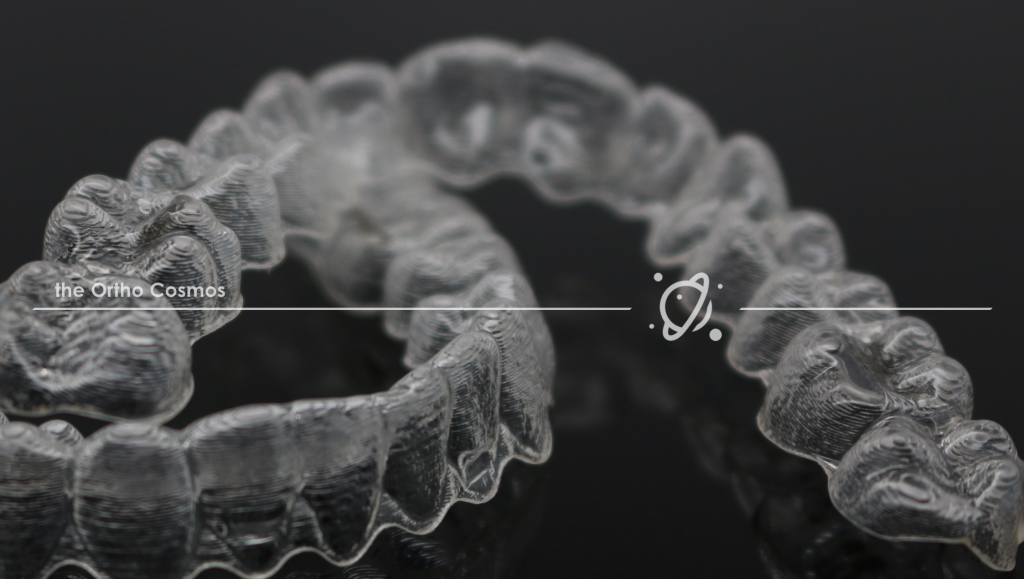Aligners are aligners are aligners…right?
With the advent of digital technology, clear aligner therapy has become a large growing segment of orthodontic treatment. In the modern-day orthodontic practice, clear aligner therapy has opened the door to the treatment of many patients who would never have sought out orthodontics. This treatment modality continues to grow at a significant pace, and with that growth, have come more options for doctors delivering care.
For patients, a clear appliance is an appealing treatment method. There is no doubt that the popularity of this esthetic appliance is a preferred choice amongst patients [1,2,3]. Most of us continue to see patients ask for clear aligners and the Invisalign appliance by name. The marketing efforts of Align Technology, Inc. and the innovation of mass production 3D printing have leveraged this treatment technique into a powerful message. The growth of the adult market in orthodontics is largely driven by the improvement of clear aligner treatment. This change in modality continues to drive adults into orthodontic treatment and has started to change the expectations of adolescents. There are many communities where children look forward to the alternative to braces.
For doctors, the primary concern that is expressed is the quality of outcome. As this method becomes more common, there is a call for data, proof, and literature that shows clear aligner therapy can keep pace with the outcomes orthodontists expect from fixed appliance treatment. Most outcome studies are linked to the development of the Invisalign product as they are the market leader [4,5,6,7,8]. Their technology advancements keep moving the needle of progress forward and grow the applicability of aligners. This growth in treating various malocclusions also leads to more analysis of the clinical outcomes that are being delivered. It begs the question of whether other entrants into the clear aligner market can deliver a comparable product.
Amongst the top reasons doctors are concerned about the clear aligner appliance, is also the cost factor. Lab fees become an added feature that we all have to consider. There is certainly a desire amongst orthodontists for competition in the clear aligner space to bring down the laboratory costs for doctors. We should also consider the cost of the appliance goes beyond the lab cost, but also in the time economics. The significance of doctor time, staff time and the additive nature of the manufacturing process all play a role in the decision making. As we consider the impact aligner therapy has in each of our offices, the CAD workflow has several areas of cost and ROI. Each aligner option has its own workflow, and the digital workflow is a foreign concept for many doctors. The freedom in having technicians prepare cases delegates a lot of duty from the doctor to a third party. Most of us realize that this delegation is not a replacement for doctor time since our involvement in the design of the appliance is critical to improve outcomes. It appears to me that many “lower cost options” and do it yourself options come with significantly more doctor time involved. This is changing through software development, but it becomes a risk. When deciding amongst aligner systems, the investment in time is a key feature to keep in mind.

When reviewing all the options available for patients, it is important to consider aligner therapy goes beyond the plastic. The development of the plastic used in the appliance is an important focus, but have you thought about all the factors that matter in choosing an aligner system? Many are available these days, and more are coming.
The main factors I would highlight in the decision of clear aligner systems are:
Material Science
There are a variety of plastics currently available for aligners. Invisalign began using the EX30 material back in the late nineties. They evolved their materials into the multilayer plastic: Smart track back in 2013. The latest Smart track plastic is proprietary and only available through the Invisalign product. Other aligner systems allow the use of plastics that are not under patent protection. These are similar to Align Technology’s EX30 material, and include Zendura, Essix plastics, Invisacryl, and others. With the varying types of plastics, the forces transmitted onto the teeth becomes an important factor. The modulus of elasticity, force degradation, temperature effect, thickness, fit and adaptability all become key metrics [9,10,11].
Software
The key to a digital system is the software that creates the CAD data. The interface of any software becomes an important decision maker with all of these options. Just like any other software you use, browser, email, word processor, and operating system all vary by the user experience. Software support, ease of use, learning curve, portability, replicability and system requirements all matter. For example, a CAD software that only runs on high-end hardware is a totally different beast from a CAD software that is cloud based and can be viewed on any device, including a smartphone. Unless you run a digital lab, orthodontists have to scale the portability of CAD data into at least every operatory in the office. Some clear aligner systems require installation and use of a native software platform that is not cloud based and very demanding on its hardware requirements.
The integration of this software is also important, so the ecosystem that it inhabits is another key feature. For example, how seamless is the link between the digital impression capture into the CAD software design. As more digital scanners become available, they will all have export features that provide image data. Just like switching between a Apple ecosystem to a Windows platform present many challenges, using various software platforms can affect compatibility and efficiency. The iTero ecosystem is an example of the software integration that Align Technology has worked hard to integrate. This ecosystem obviously links scans to aligner case submissions to improve digital workflow, but also links the clincheck process to outcome simulation and progress tracking of clinical cases.
Scale
Clear aligner treatment can be used as a small subset of an orthodontic practice, or can command a significant amount of production in an orthodontic practice. The term “share of chair” has become more common in describing the percentage of utilization of aligners vs. fixed braces in the orthodontic business. Many clear aligner systems have the advantage of a lower cost per case compared to the market leader, Invisalign. With lower costs and a potential commoditization of aligners in the orthodontic marketplace, why would anyone consider using a more expensive system over a cheaper alternative? My perspective is scalability. Having tested many different aligner systems, scaling both the design and manufacturing of CAD/CAM designed aligners has many factors that Align Technology has mastered and that become a challenge for the average orthodontic practice.
Since clear aligner systems cost more than fixed appliances, the advantages when using clear aligners come from time economics. A digital system has the potential to reduce staff and gain productivity. The challenges I have experienced is in the digital workflow and the clincheck dilemma. This means that digital workflow requires digital efficiencies and care in the doctor time needed. The best clear aligner systems should protect the time economics of taking lab workflow into the practice. Delegating more of the workflow into an experienced company can save time. Taking on more of the workflow in-house will add challenges in developing a scalable model that does not trade laboratory savings with a significant increase in staff time and worse yet, doctor time.
Outcomes
When it comes to a comparison of clear aligner treatment data, the market leader continues to be the Invisalign system. Since more than four million patients have been treated using this clear aligner system, the power of data in orthodontics becomes much more evident. Simple cases can be treated with CAD methods and aligner manufacturing that was available two decades ago. Invisalign did it back then, and the large surge in clear aligner options will do so as well. The change in upcoming treatment quality and outcome studies will likely be affected by the data driven treatment design. The addition of data-driven staging and optimization are the current examples of how the Invisalign product has evolved from a rudimentary appliance, to a competitor to fixed appliances. As aligner systems are released to the market, the data-driven decisions in the design of the appliance will be a critical component for doctors who are concerned about the outcomes they deliver from plastic. Everything from attachment design, staging, to force systems, make a difference. Experience in the design of appliances and manufacturing play critical roles in the use of different clear aligner systems. Are you a practice that treats only simple cases? Have you developed a skill in treating more complex cases? The applicability and predictability of the aligner system you choose to use makes a difference in the choice of current appliances.
Branding/Marketing
Consumer acquisition has also become an important factor in the clear aligner market. Since Invisalign has become a household name, they have leveraged the name recognition to get millions of people asking for the product by name. So far, Align technology is the marketing leader in this arena and continues to drive prospective patients into its doctor locator website and more recently into its concierge service. These marketing efforts are clearly meant to keep the large investment in branding within the Invisalign brand. That is part of the cost of using their product, and a value add promoted by Align Technology, Inc. This comes from the fact customer acquisition continues to be a concern for most orthodontists, and new patient flow is the life blood of an orthodontic practice.
References:
1. Miller, et al. A comparison of treatment impacts between Invisalign aligner and fixed appliance therapy during the first week of treatment. AJODO. 2007 March;131(3):302
2. Rosvall, et al. Attractiveness, acceptability, and value of orthodontic appliances. AJODO. 2009;135:276.e1-276.e12
3. Abbate, et al. Periodontal health in teenagers treated with removable aligners and fixed orthodontic appliances. J Orofac Orthop. 2015 May;76(3):240-50
4. Djeu, G., C. Shelton, and A. Maganzini, Outcome assessment of Invisalign and traditional orthodontic treatment compared with the American Board of Orthodontics objective grading system. Am J Orthod Dentofacial Orthop, 2005. 128(3): p. 292-8
5. Kuncio, D., et al., Invisalign and traditional orthodontic treatment postretention outcomes compared using the American Board of Orthodontics objective grading system. Angle Orthod, 2007. 77(5): p. 864-9
6. Gu, J., et al., Evaluation of Invisalign treatment effectiveness and efficiency compared with conventional fixed appliances using the Peer Assessment Rating index. American Journal of Orthodontics and Dentofacial Orthopedics. 151(2): p. 259-266
7. Zheng, M., et al., Efficiency, effectiveness and treatment stability of clear aligners: A systematic review and meta-analysis. Orthodontics & Craniofacial Research
8. Kravitz, et al. How well does Invisalign work? A prospective clinical study evaluating the efficacy of tooth movement with Invisalign. AJODO 2009 Jan;135(1):27-35
9. Kohda N, Iijima M, Muguruma T, Brantley WA, Ahluwalia KS, Mizoguchi I. Effects of mechanical properties of thermoplastic materials on the initial force of thermoplastic appliances. Angle Orthod. 2013;83:476–483
10. Fang D, Zhang N, Chen H, Bai Y. Dynamic stress relaxation of orthodontic thermoplastic materials in a simulated oral environment. Dent Mater J. 2013;32:946–951
11. Hahn W, Dathe H, Fialka-Fricke J, Fricke-Zech S, Zapf A, Kubein-Meesenburg D, et al. Influence of thermoplastic appliance thickness on the magnitude of force delivered to a maxillary central incisor during tipping. Am J Orthod Dentofacial Orthop. 2009;136:12.e1–12.e7

Leave a Reply